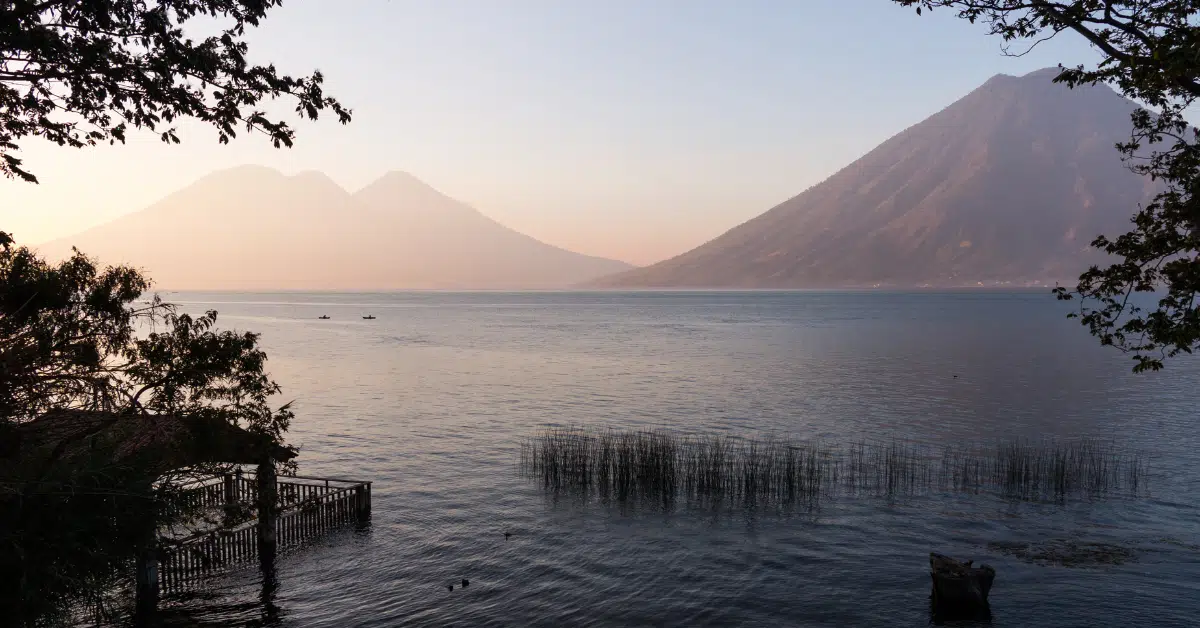10 Most Impressive Volcanoes in Guatemala
Guatemala is home to 37 unique and awe-inspiring volcanoes, so you’ll never be far from one of these impressive giants during a visit to Guatemala. The variety of these unique volcanoes is impressive: you’ll find everything from highly active cones with fire and lava shooting from their craters to extinct volcanic crater lakes with peaceful, forested slopes.
In this ultimate guide to the ten most impressive volcanoes in Guatemala, we share some of the most incredible Guatemala volcanoes you can hope to visit, well worth adding to your Guatemala itinerary. Don’t miss our choice of the most impressive volcano in Guatemala and recommendations for how to visit each one!
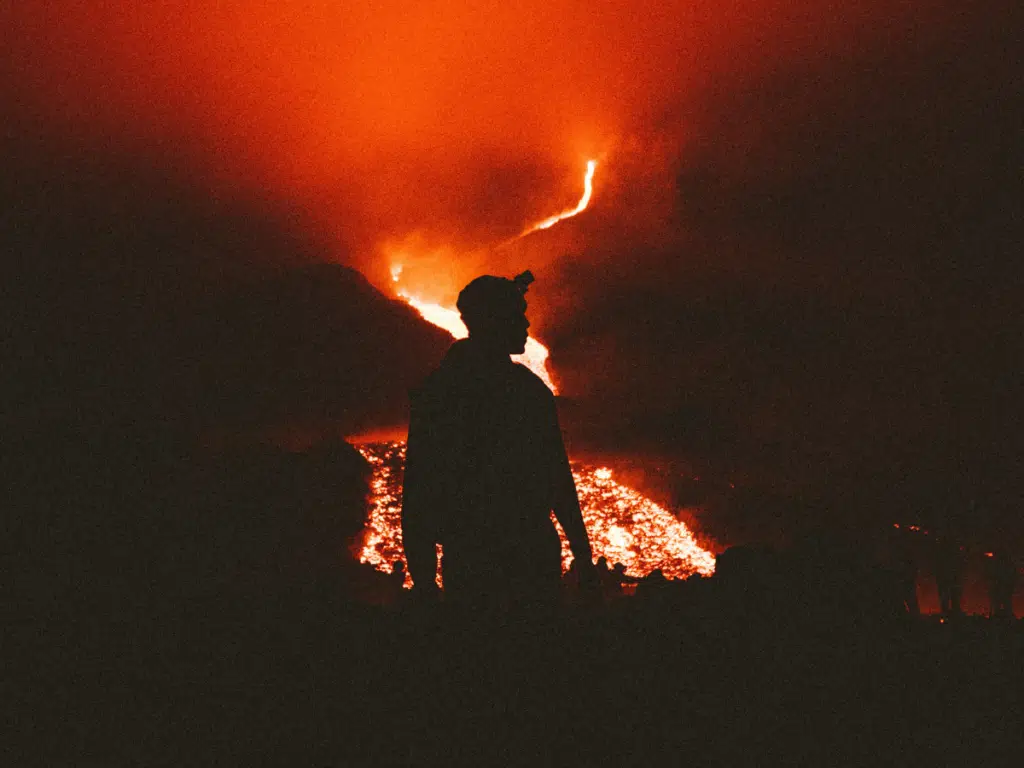
Volcanoes in Guatemala
With both superactive and long-dormant volcanoes, Guatemala has an array of impressive and powerful volcanoes to visit. Whether you head all the way across the country to conquer a Guatemala volcano hike or head to Lake Atitlan where there are too many volcanoes to keep straight, witnessing or climbing one of these impressive cones is a highlight of a visit to Guatemala.
These are the most impressive volcanoes in Guatemala and the best to visit on your Guatemala itinerary!
1. Pacaya
Located just an hour and a half south of Guatemala City, Pacaya is one of the most famous volcanoes in Guatemala – and one of its most active. Standing at 8,373 ft (2,552 meters), it is impressive in height but still not among the tallest Guatemala volcanoes you’ll find on this list!
Pacaya was previously dormant for years until a violent eruption in 1961 kicked off a period of activity that continues today. Notable eruptions occurred in 1998 and 2010, and while the volcano is still active, it’s been much more subdued lately and perfectly safe for a visit as vulcanologists continue their close monitoring.
Hiking Pacaya is a popular activity, so visiting means you’ll be sharing trails with other travelers, especially if you visit during the summer months. You can only hike Pacaya with a guide, so it’s most convenient to organize a Pacaya guide from Antigua or Guatemala City, so you’ll also have transportation to make it to the volcano.
Along the paths, you’ll also roast marshmallows over glowing, steaming volcanic rocks and eat pizza cooked on Earth’s natural pizza oven! It sounds a bit campy, but it’s actually great fun and a reminder of the incredible power and force bubbling below your feet.
2. Tajumulco
Standing at 13,789 ft (4,203 meters), Volcán Tajumulco it’s not only the highest peak of a volcano in Guatemala, but in the entire Central America region. This quiet, inactive volcano has no recorded eruptions on record, but even without the threat of activity, its size is enough to intimidate.
If reaching the highest point in Central America doesn’t sound appealing enough to you, how about a view over at least 15 other volcanoes in Guatemala? If you’re lucky enough to reach the summit on a clear day, the view can stretch as far as the Pacific Ocean and Mexico.
Tajumulco lies in the Sierra Madre de Chiapas region in southwestern Guatemala. While Tajumulco is located in a relatively remote area, the easiest way to embark on a visit to the volcano is from San Marcos.
While reaching the summit is doable in one day (total hiking time is about 7-9 hours), spreading it out over two days is recommended. This way, you get a beautiful sunset on your first night, and you’ll be able to admire the view from the top at sunrise.
The hike is not incredibly complicated, but the altitude has its effects. A permit is not required to enter the volcano, and for experienced hikers, a guide is not absolutely necessary. For inexperienced hikers, however, taking a guide is highly recommended.
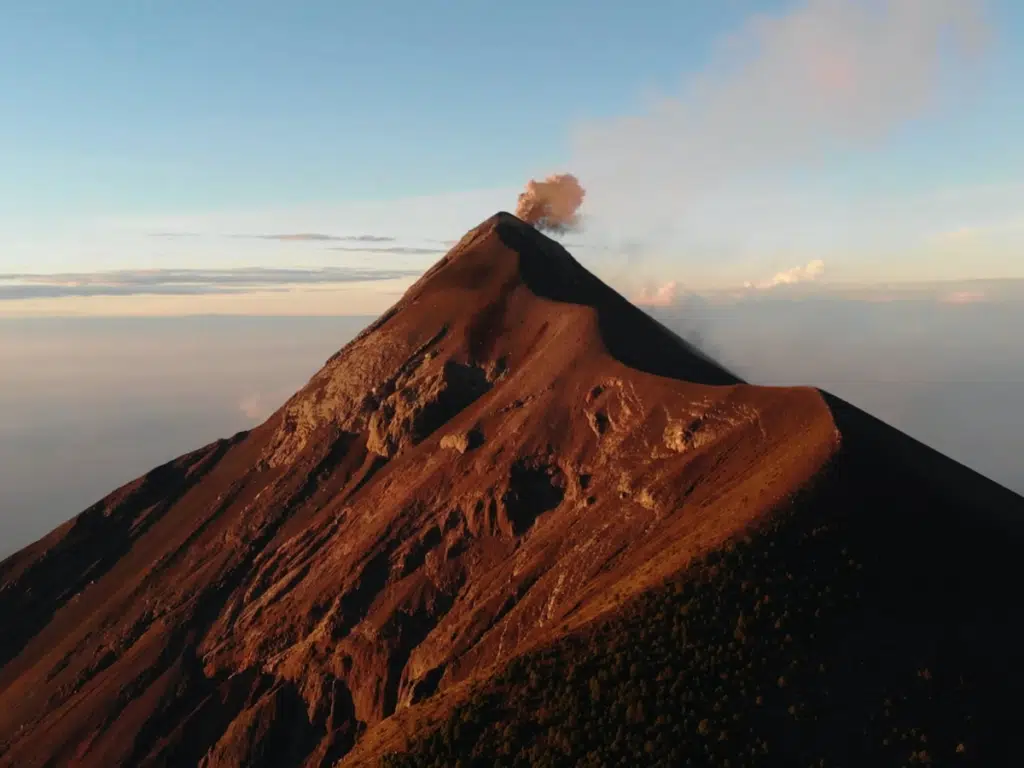
3. Acatenango
One of the three volcanoes in Guatemala surrounding the colonial city of Antigua, Acatenango (in addition to Fuego and Agua) is part of an incredible skyline and scenery that set Antigua apart.
Soaring over the city at 13,045 feet (3,976 meters), Acatenango is relatively inactive, with a few small and limited eruptions in the 1920s and 1970s, especially quiet compared to its sister volcano, Fuego.
While you’ll catch glimpses of Acatenango from all corners of Antigua, hiking to the twin peaks at the summit is an unforgettable way to visit, offering spectacular views over the other two volcanoes and the city from there.
Hiking Acatenango volcano can be done in one (very long day) or via a 2-day trip where you spend a night camping with a front-row view of Guatemala’s fiercest volcano, Fuego. The hike – which requires a guided tour from Antigua – begins early and requires a 7-hour uphill climb to the campsite.
As it gets dark over Acatenango, expect to see nature’s fireworks display from neighboring Fuego just a few meters before you. This can be experienced all night, so don’t expect a good night’s sleep. However, it’s a memorable feature of a visit to Acatenango.
In the morning, you’ll wake up for sunrise and hike up the crater lake of Acatenango to get a panoramic view of countless volcanoes in the distance.
Read More: Antigua Guatemala: Ultimate Travel Guide
Travel Essential
Don’t think about traveling without a good VPN (Virtual Private Network). Using a VPN while connecting to the internet is an easy way to keep your personal information safe from hackers and trackers. We’ve used NordVPN for years and couldn’t recommend it more – it’s a must for safety online, at home or abroad.
4. Tacaná
Located directly on the Guatemala/Mexico border, Volcán Tacaná (known as Volcán Tacina) is an incredible sight to behold. Located within the Sierra Madre de Chiapas mountain range, this towering volcano is the second tallest peak in Guatemala, measuring 13,320 feet (about 4,060 meters).
While the last eruption of Tacaná was a small one in 1986, it could pose threats to surrounding communities should it erupt again in the future.
Located in a remote corner of the border, Tacaná isn’t on the top of many Mexico or Guatemala itineraries, but hiking Tacaná is a real treat. The volcano sits within a UNESCO Biosphere Reserve, and the slopes of Tacaná are home to lush forests and countless unique species of plants and animals of all kinds.
The trek up the volcano will take you through the jungle and past a series of waterfalls that cascade down its sides. To reach the top, you can hike independently or pay a local guide, though the journey lasts about 10 hours, so make sure to bring good hiking equipment.
Tacaná can be summited from either the Mexico or Guatemala side, and leads through lush rainforest and remote villages, past ancient magma flows and incredible panoramic views.

5. Agua
Towering over the charming colonial city of Antigua, Agua Volcano is perhaps the most photographed volcano in Guatemala for its picturesque position beyond the Santa Catalina Arch, one of Antigua‘s most recognizable landmarks.
While Agua is extinct, its current name originates from a historic mudflow that descended from its slopes in 1541, destroying the then-capital of colonial Guatemala and leading the capital to relocate to Antigua.
If you’re looking for more than just a photo opp from Antigua, consider visiting the volcano’s slopes or making the 4-5 hour trek to the top. You can visit coffee plantations and local villages on Antigua day trips and excursions for an in-depth introduction to the volcano and the people who call it home.
The climb is quite challenging and steep in areas, and crime has been reported on the lower areas of the ascent, so make sure to make the trek with a local guide – you’ll find plenty of guides offering services in Antigua.
6. Fuego
Fuego is the most active volcano in Central America and only one of the three active volcanoes in Guatemala. This beautiful beast just 16 kilometers away from Antigua is 12,345 feet tall (3,763 meters) and has been actively erupting since 2002, releasing towers of ash, smoke, fire, and even lava and pyroclastic flows periodically since then.
Despite Fuego’s activity, almost every tour operator in Antigua will offer to take you to the volcano if the conditions allow for it, per the guidance of the vulcanologists who closely monitor its activity.
The adventure will start by taking a bus from Antigua to La Soledad, about 2 hours from Antigua. You’ll start hiking Acatenango, Fuego’s twin volcanic peak. You’ll set camp there, and the next morning, the guides will wake you up early (around 3 or 4 AM) to start walking to Fuego.
You’ll walk in the dark, getting closer and closer to the crater with only your water, headlamp, and camera. When you reach the safe point at Fuego, the sun will begin to rise, providing an incredible view that will make your efforts worthwhile.
That same day, you’ll return to camp to get your things, come back down to La Soledad, and then head back to your hotel in Antigua for a well-deserved shower and beer.
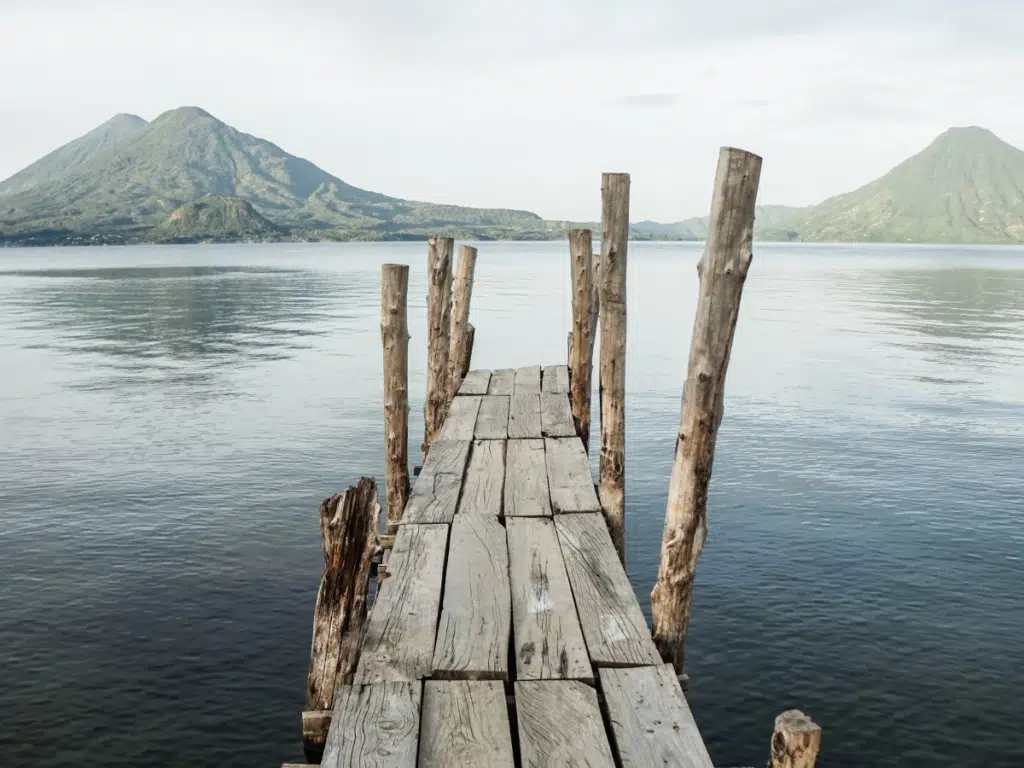
7. Atitlán
Beautiful Volcán Atitlán is the tallest of the three impressive volcanoes on spectacular Lake Atitlán, one of the most beautiful lakes in Central America. Standing at 11,598 feet (about 3,500 meters) above sea level, the summit of Atitlán is the eighth-highest volcano in Guatemala and one of the most difficult to climb.
The trailhead starts at about 5,905 feet up the volcano (1,800) meters, leaving eager hikers with about a 5,000-foot climb (1,700 meters) to the top. While the trail is fairly obvious near the bottom, starting early (often in the dark) is best, and the path gets increasingly difficult to navigate as you head up.
For the last hour of the hike before reaching the summit, you will face plenty of loose rocks and soft shale. But once you reach the top, you are treated to incredible views of the lake and as many as a dozen unique Guatemala volcanoes in all directions. The hike usually takes 5-6 hours.
Access to Volcán Atitlán is from the city of Santiago Atitlán, on the south side of Lake Atitlán, which is approximately 3 hours by car from either Antigua or Guatemala City or just a short boat ride from other villages around the lake.
8. Ipala
Located in eastern Guatemala, near some incredible hot springs in El Salvador, Ipala Volcano is one of the most unique volcanoes in Guatemala. Long extinct, Ipala’s volcanic crater is now filled with water, making for a stunning hiking destination with incredible views.
A visit to the peaceful Ipala volcano is low impact and high reward. The hike from the start of the trails to the crater rim is easy and takes most hikers an hour or less. Many visitors make the quick one-hour drive from Chiquimula to visit, which can easily be done by taking a bus to the entrance or hiring a car.
Around Ipala and near the entrance, you’ll find food vendors, spots for camping, and even locals renting horses to take you to the top for a few quetzals. If you’re expecting a nice day, make sure to bring your bathing suit, as you can swim in the crater lake!
Though far off the beaten path compared to some of the more popular volcanoes near Antigua and Lake Atitlán, Ipala is a fantastic destination for an unforgettable getaway at one of the most scenic and unique volcanoes in Guatemala.
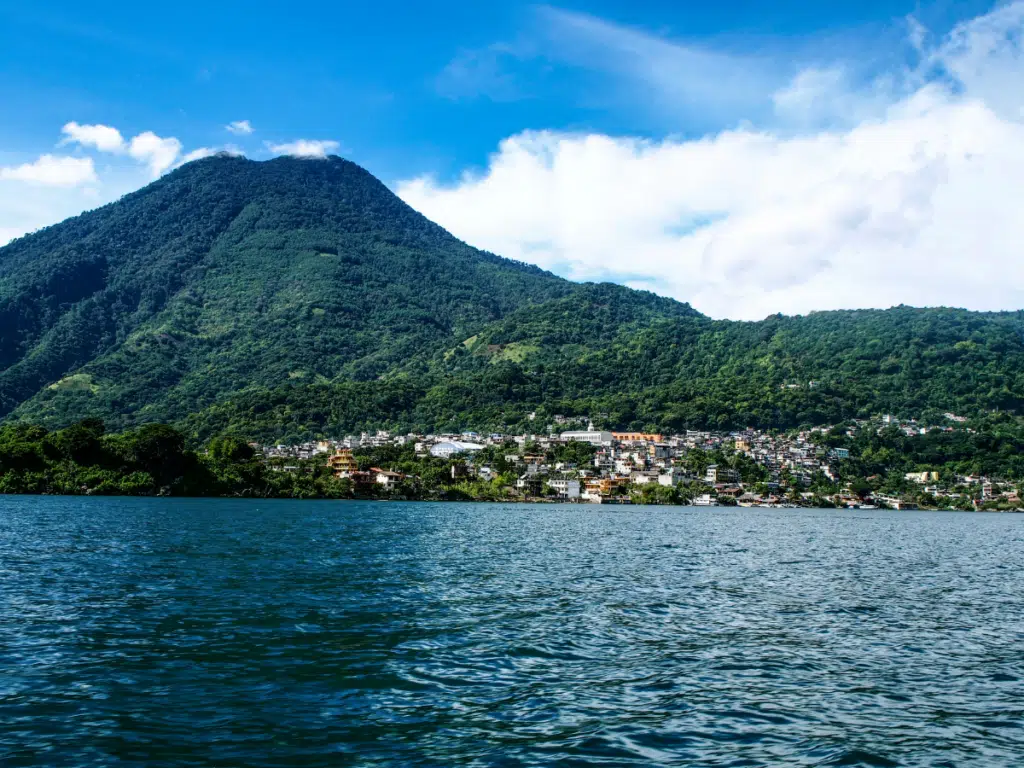
9. San Pedro
San Pedro is a dormant volcano located in San Pedro La Laguna at the shore of Lake Atitlán, whose slopes have been a national park since 2006. Towering 9,908 feet (3,020 meters) over the lake, you can easily admire it from the rooftop bar at your hotel or, of course, by hiking to the summit.
Whatever option you choose, you are in for a stunning view. If you want to hike this volcano, you could rent a car in Guatemala City or Antigua and make a family road trip to Lake Atitlán, or easily visit from any of the surrounding Lake Atitlán towns.
The volcano is covered in thick vegetation and stunning forests, so on the way up, you won’t be able to see much other than flora and fauna ahead of you. However, when you reach the summit, and the forest opens up, you’ll take a deep breath and get an incredible view of Lake Atitlán and the surrounding volcano peaks.
While the hike to the summit lasts about 4-5 hours, it’s only moderately challenging. Plan to travel with a guide for safety and to learn about the wildlife you’ll see along the way.
10. Tolimán
One of the many impressive peaks surrounding Lake Atitlan, Tolimán Volcano sits just north of its twin volcano Atitlán, and makes for an essential part of the “skyline” of the lake. Long extinct and covered with lush forests, Tolimán is a beautiful destination offering expansive views, opportunities to see beautiful wildlife, and more.
While Tolimán might not be as popular of a hiking destination as San Pedro, it’s well worth a visit and is only an easy to moderately challenging hike at best. Plan to visit with a guide from Santiago Atitlán, or hike on your own.
You can plan to camp on the volcano as well, though you’ll need to bring your own gear and provisions.
Guatemala Volcanoes
Whether you’re looking to hike Acatenango for a view of fiery Fuego or prefer a peaceful hike to the stunning crater lake of Ipala among hot springs, no two experiences with one of these impressive volcanoes in Guatemala are alike. Start planning your Guatemala itinerary, just make sure to add one of these Guatemala volcanoes to your bucket list!

Carley Rojas Avila is a bilingual New York-based travel writer, editor, content marketer, and the founder of the digital travel publications Explorers Away and Home to Havana. Carley is an expert on all things Latin America, the Caribbean, and Cuba, having lived and worked in four different countries in the region. Her writing has appeared on the Associated Press wires and in Travel + Leisure, Yahoo, MSN, Euronews, The Weather Channel, and more. When she's not writing about her travels, find her front row at a Bad Bunny concert, befriending street cats, and taste-testing every pizza in Havana.

